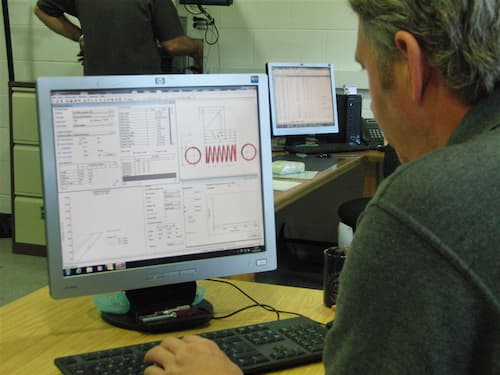
We help clients take new products to market faster by assisting with spring design and ensuring our products meet your exact requirements.
By working closely through the development stages we helped SpiralGrip realise their vision of creating an innovative desk edge cable holder.
“The guys at Airedale Springs couldn’t have been more helpful in developing SpiralGrip. They worked with us on the design, sourced special material from the Far East and were very much part of the team taking the product to market. Their approach should be a lesson to all British manufacturing businesses.”
Cliff Burgin, Managing Director of SpiralGrip Limited
This demonstrates how an idea and spring design developed at the machine can vastly reduce the timescale from concept to launch. At Airedale we have the capacity to offer this personal service and help clients bring ideas to life and on to market.
How We Design Our Springs
Our technical team use the latest computer software to help design compression, extension and torsion springs and uses innovative simulation software on our CNC machines to try out ideas and perfect the spring design at a fraction of the cost of setting up the machine.
Extension Spring Design
When we design extension springs, we take several factors into consideration, such as how much force the spring needs to be able to generate, whether it needs preload stretching, the number of coils (which can determine the strength of the extension spring), and the hook configuration. We’ll also take into account the nature and purpose of the spring during the design process when deciding on the ideal dimensions.
Extension springs are similar to compression springs but are loaded in tension. Hooks or loops are provided to allow a force to be applied, as extension springs are usually attached at both ends to other components. When these components move apart, the spring tries to bring them together again.
Compression Spring Design
As compression spring manufacturers, we understand that the design of a compression spring will depend on its intended function. We will also determine parameters such as wire diameter, free length and spring rate on a case-by-case basis.
A compression spring is an open-coil helical spring that offers resistance to a compressive force applied axially. They are the most common spring configuration and are one of the most efficient energy storage devices around. When you apply pressure to a compression spring, making it shorter, it pushes back against the load, trying to get back into its original length.
Torsion Spring Design
When designing torsion springs, the most important starting point is the amount of torque required. Once established, our designers will then make a determination on the appropriate proportions, such as wire size and diameter, as well as the number of coils and whether the torsion spring should be ‘right-handed’ or ‘left-handed’. Airedale have also developed methods to design torsion springs that do not suffer from significant tangling problems.
Torsion springs are ideal where there is a requirement for angular movement with the legs of the spring attached to other components. When those components rotate around the centre of the spring, the spring tries to push them back to their original position. Torsion springs are used for hinges, counterbalances and lever return applications.
A little expert advice in the early stages of your spring design can help improve your product and avoid costly modifications or redesigns later.
Frequently Asked Spring Design Questions
What factors are crucial in designing a spring?
Designing a spring involves careful consideration of several factors. Material selection is paramount, taking into account tensile strength, shearing stress response, and corrosion resistance requirements.
How do physical constraints impact spring design?
The physical space available for the spring, the load it must support, and the required compression or extension speed all influence the design process.
Do spring designers use specific formulas and guidelines?
Yes, most spring designs follow established formulas and principles of physics to ensure the spring meets both client requirements and performance standards. General guidelines are followed initially, with more precise procedures to refine the design.
How is technology used in spring design?
Advanced computer technology is employed to simulate the spring’s behaviour. This cost-effective method allows for testing and refinement of the design, minimising the need for costly prototypes.
How does customer collaboration play a role in spring design at Airedale Springs?
Our design process places significant emphasis on customer collaboration. By working closely with clients, we ensure that the spring design is right the first time, reducing the need for costly and time-consuming modifications.
Does Airedale Springs accommodate both large-scale and small batch orders?
Yes, whether you need a large order, a small batch, or even a one-off spring, Airedale Springs offers expert advice and top-quality design services to meet your specific needs.


